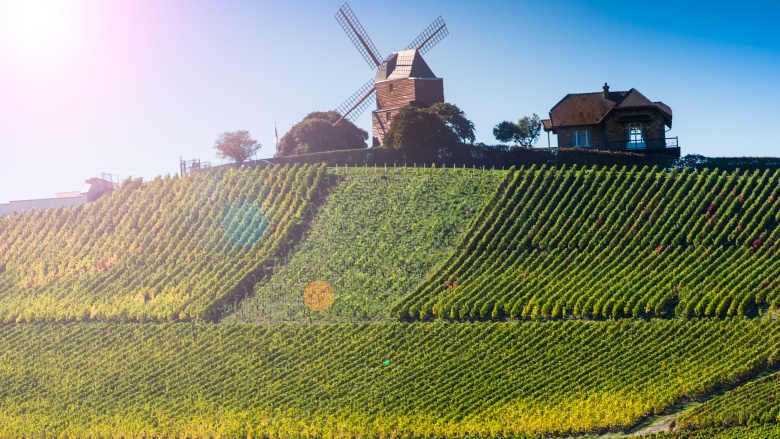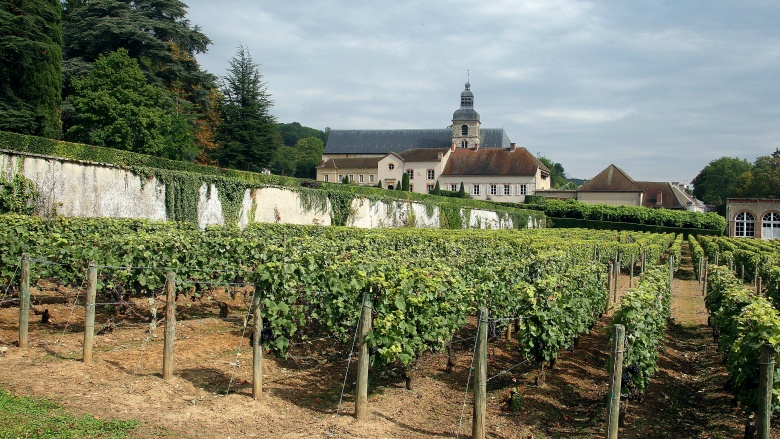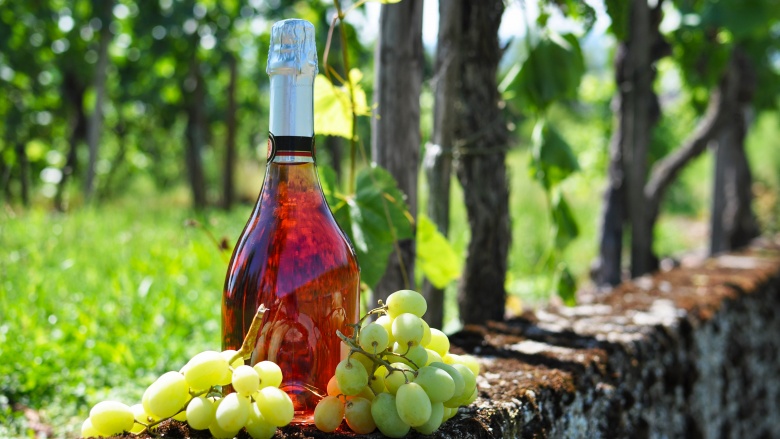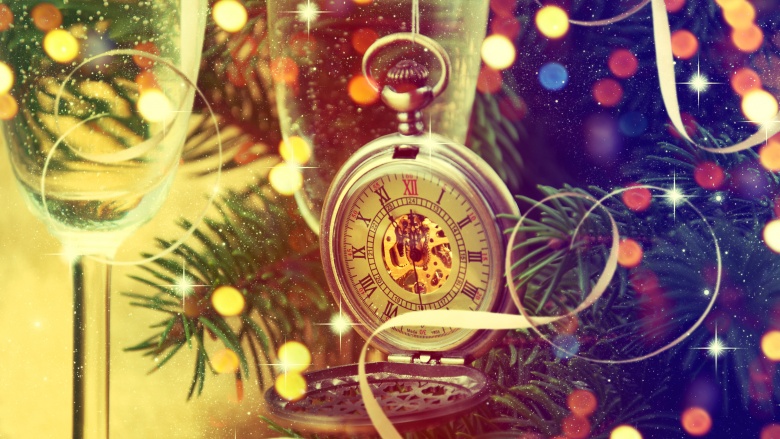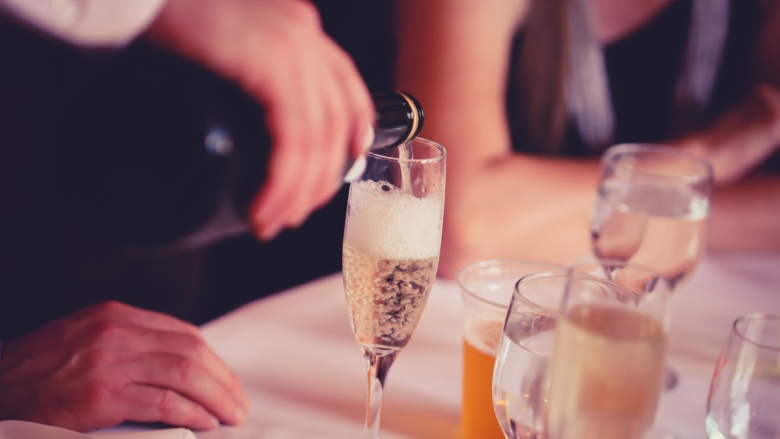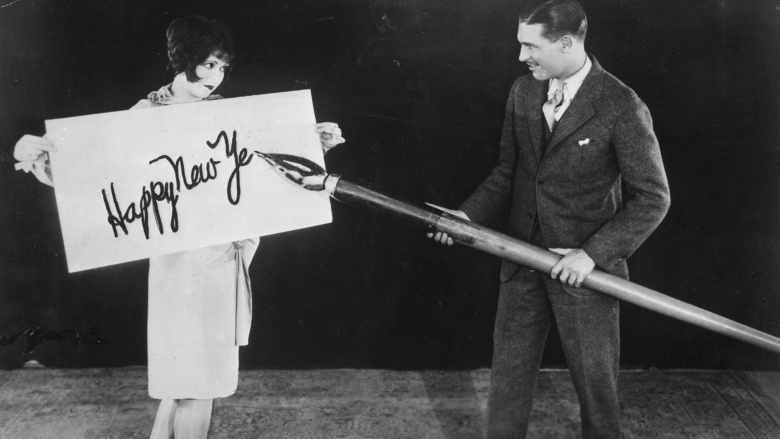The Real Reason We Drink Champagne On New Year's
No New Year's Eve would be complete without welcoming the new year (and bidding an enthusiastic farewell to the prior year) with a bottle of bubbly. It's the stuff of celebrations and special occasions, and it's such a big part of holiday traditions around the world that about 25 percent of all champagne is sold in the days between Christmas and New Year's Eve. Just what is it that makes champagne the perfect New Year's drink? You might be surprised.
The beginning of a royal region
To start at the beginning, let's go back much, much farther than you were probably expecting to go — 1,500 years ago, give or take, to the end of the fifth century. At the time, King Clovis was fighting to defend his territory, and the story says he promised his wife (Clotilde, from the central region of Burgundy) that if he was victorious, he would not only become king of all the areas of France, but a Christian, too.
Clovis did succeed, and he became the first king to unite previously independent groups under one rule. He managed to figure out a way to combine things like Christian edicts and Roman rules in what's now France in a way that started the country on its current path. You're probably wondering what this has to do with champagne — we're getting to that.
The popularity of the drink started with the establishment of the region as something royal. Clovis kept his promise to his wife and was baptized in Reims, deep in the heart of France's Champagne region. When he was baptized, it was no small affair and for centuries, French kings continued to be crowned there. That, as you can imagine, was never a small affair either. In the days before transportation happened in the relative blink of an eye, that meant a royal court could expect to spend ages at any given location. Reims (and Champagne) became the stuff of regal change and royal celebrations that always included some of the region's finest local wines.
Dom Perignon and Louis XV
Now that you're a little more familiar with the history of the region and just how important its local wines have always been, let's fast-forward a bit to the end of the 1600s. That's when a particular Benedictine monastery at Hautvillers acquired a new cellar master. He was a monk named Dom Perignon, and yes, the name on your champagne bottle really did belong to a real person. Sparkling wine was already common enough, and it's a bit of a stretch to suggest he's the one that invented champagne. He did, however, figure out something that had plagued vinters for generations: how to use red grapes to make a white wine. According to the story, Dom Perignon said of his creation, "Come quickly, I am drinking the stars." (As epic a statement that is, it's sadly untrue.)
While he might not have actually said that, he did, however, expand the monastery's vineyards, develop the practice of using corks, and figure out how to secure the corks against the pressure that builds up inside of bottle of sparkling wine. Strangely, he also started trying to figure out how to keep the bubbles from forming, but he never succeeded in that particular endeavor. But he did cement the reputation of Champagne as a major producer of champagne, and by the beginning of the next century the bubbling, sparkling wine had become such a favorite of French royalty that King Louis XV started making laws governing just what could be called champagne and how it could be sold. The only wine that could be sold in bottles, his complete endorsement of the product made it not only popular at the royal court, but among the would-be royals and nobility, too.
Champagne's celebratory lineage
The wines Dom Perignon was experimenting with had already been a part of royal coronations for centuries, and only a few decades after the Benedictine monk made his improvements, champagne was front and center at another celebration: the Fete de la Federation. That was in 1790, and Champagne-region wines were the only ones used to celebrate the end of the French Revolution. Not long after, champagne became an integral part of the Congress of Vienna, and after that it was widely used to celebrate the signings of major treaties and the end of diplomatic meetings.
Champagne became the drink of choice at a huge number of landmark celebrations, from royal weddings to the scaling of some of the world's toughest mountains. It then also became linked with New Year's celebrations, which started first with Julius Caesar. It wasn't until the 1800s that staying up for a midnight party became a common tradition, and we know champagne was a major part of it from at least mid-century.
Champagne on New Year's
By the middle of the 19th century, champagne's popularity had undergone something of a trickle-down effect. The upper echelons of society loved it, the nobility wanted to emulate them, the pseudo-nobility wanted to fit in, and the merchants, the middle class, and the working class felt there was no reason they shouldn't be allowed to join in the festivities — and they did.
Champagne wasn't always the only New Year's drink, even though written references to mid-century celebrations usually do mention champagne. Another popular drink was arrack punch, described as a "villainous compound" in one 1852 account. That particular cocktail was a favorite of Charles Dickens, though by the time he was serving it to his party guests it was already something of a vintage item. The rum-like liquor came from Asia, where it was distilled from palm tree sap. According to one mixologist, the punch made from arrack looks not unlike soy sauce, so it's not surprising that the clear, bright, fun bubbly went flying past arrack in popularity.
By the end of the 19th century, most New Year's parties were serving champagne. In the five decades leading up to the start of the century, champagne sales skyrocketed from 6 million bottles per year to a staggering 28 million, and in the 1930s a popular New York restaurant made sure it was the thing to drink.
Cafe Martin
The restaurant was Cafe Martin, and it opened in 1902. Run by a pair of French brothers, the cafe became not just the place to be seen, but a place for the most fashionable, who's who of the still-young country's upper class. The Martin brothers, who had opened their first restaurant a few decades before, capitalized on the romance of their European homeland to provide a suitably exotic dining atmosphere. By 1903, they had a menu that not only charged the now-unthinkable price of $1.50 for dinner, but that also advertised their selection of 69 different champagnes. Their importing of these champagnes was a hugely profitable part of their business, and New Year's (along with other holidays, like Christmas), became one of their biggest, most profitable days.
They capitalized on it by pushing champagne in a way that made their customers feel like it was something special. The Cafe Martin became (it's thought) the first place to become a "champagne only" restaurant for New Year's, at least after 9 p.m. By the time that rule was put in place, it was such a trendy place to be that people were more than happy to only drink champagne if it meant being seen in one of the hottest places in New York City for New Year's Eve. The staff at Cafe Martin was also more than happy to promote champagne as the drink of the night, too. For each bottle they popped and each cork they saved, they would earn a bit of a bonus.
New Year's during Prohibition
"But wait a minute," the history buffs among you might be saying. "What about the years during Prohibition? How did the champagne tradition survive?"
Piecing together the details on this one is more than a little difficult, as alcoholic activities during Prohibition were, by necessity, pretty hush-hush. Most of the clues point to an epic conclusion: it wasn't impacted too much. Prohibition became law on January 16, 1919, and that meant the government had almost a year to prepare to crack down on the revelries that had traditionally happened every New Year's Eve. But by the time the country was getting ready to ring in 1920, there were only 1,400 agents dedicated to hunting down any illegal alcohol consumption. Given that they were tasked with enforcing prohibition across the entire country, the likelihood that a fed was going to come knocking on your door was slim to none. In spite of the fact that John Kramer, Prohibition Commissioner, promised that every sip of alcohol was going to be prosecuted, it definitely wasn't.
If you take a look at what was happening overseas as Prohibition was kicking into high gear, you'll find that at the time the US was still importing champagne — just using less direct routes. The entire industry was still reeling from the impacts of World War I and the loss of the custom of Germany and her allies, but the American market held strong throughout Prohibition. Numbers aren't exact, obviously, but around 70 million bottles of champagne were still shuttled into the US between 1920 and 1933.
There were still plenty of options for the determined reveler, too. So-called booze cruises headed out into international waters and beyond the reach of law enforcement, and the sale of alcohol was still legal when it was purchased with a prescription (a prescription for fun!). Things took a dark turn at the holiday season of 1926, when scores of people fell sick (with more than 30 dying) after drinking alcohol poisoned by the government in an attempt to curb holiday drinking. Some estimates suggest that the nation-wide alcohol poisoning program killed somewhere around 10,000 people, but when Prohibition was repealed it was business as usual for New Year's. That meant champagne toasts were back — and they still haven't left.

